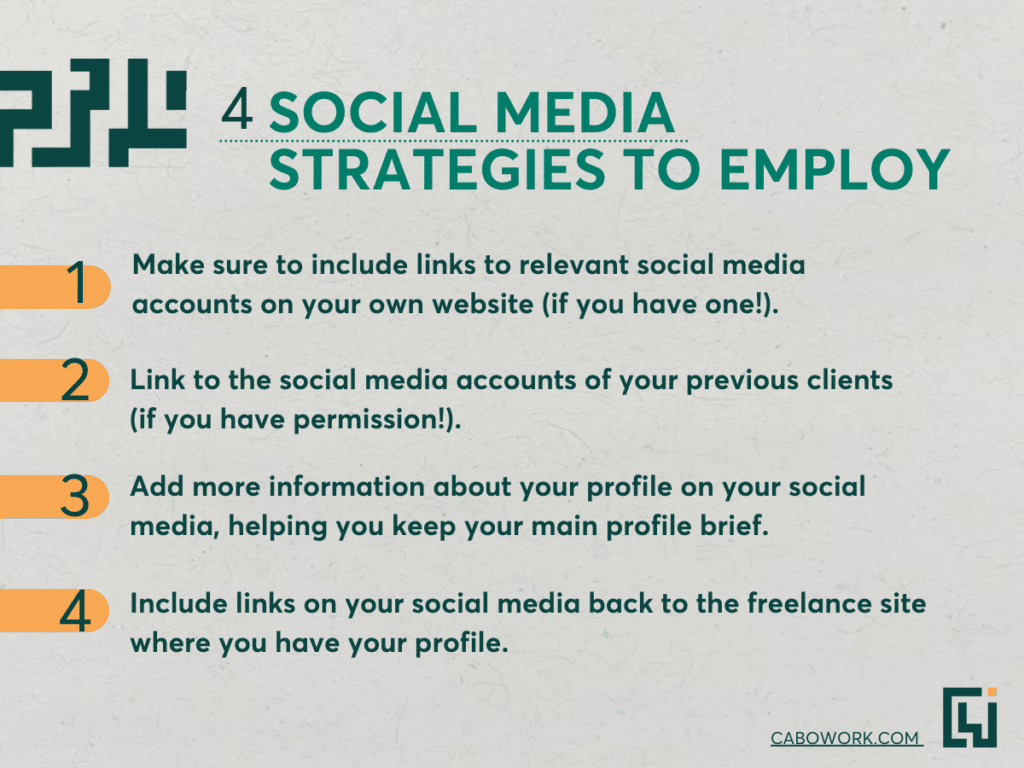Create a winning freelance profile that stands out – Where do you start?
First impressions matter.
In the world of freelance, your profile should be a brief window into who you are as a remote worker and what you offer. How well your profile is written can spell the difference between potential clients flooding your inbox for interviews, or skipping you and moving on to the next.
For ease of reading, we’ve broken down this guide into three steps, which are:
- Step 1: First impressions
- Step 2: Building unique content
- Step 3: Final touches
While we recommend you read our guide from start to finish, you are welcome to use our index table above to skip to the parts that interest you the most.
Whether you want to create a winning LinkedIn profile, or want to make your freelance profile stand out (Upwork, Freelancer, Fiverr etc), you can apply each of these tips. Creating a fantastic freelance profile is an important step to becoming a successful freelancer – we hope you enjoy the process!
Step 1: First impressions matter
Before we write some award-winning content, let’s begin with a few (equally important) parts of your profile that should not be overlooked. From choosing a winning profile photo to writing an informative headline, it’s important to take care when creating all parts of your profile. Let’s make those first impressions count!
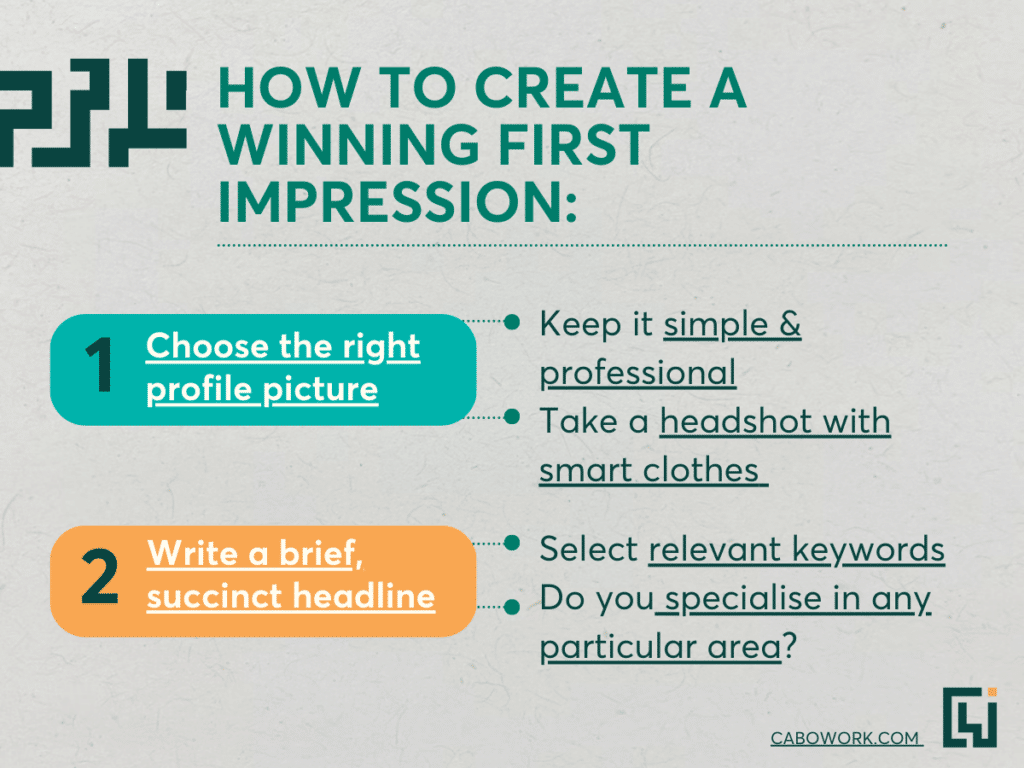
Select the right profile picture.
When creating your freelance profile, one of the first options you will have is to upload your profile photo. While you don’t need to go out and spend hundreds of dollars on a professional photo shoot, it may be worth getting in touch with a photographer if you’re feeling stuck.
Why is choosing an appropriate profile picture important?
A picture, as the old saying goes, tells a thousand words.
Around 80% of recruiters agree that your profile picture helps them get to know you better. By the same token, an unprofessional profile photo can project an unfavourable impression, leaving your potential employer with no choice but to click on to the next candidate.
Most websites, including job board sites like Upwork and Freelancer, show your profile picture alongside a small snippet of your bio. This is a great opportunity to grab your audience’s attention, without having to write a single word!
How to take the perfect freelance profile photo:
So, how do you take a fantastic profile photo that draws in potential employers? Have a look at some of the following tips:
- Take a headshot, from your shoulders up, wearing professional clothes. A nice shirt or blouse will be fine, but if you’d like to wear a suit, go for it!
- Try to keep your profile photo to just you.
- Keep it simple – A plain/single-colour background (non-jarring)
Now these rules can be (and are often) bent, however when doing our research on the profile pictures of the most successful freelancers, all of them had the above three points in common.
Write a brief, succinct headline.
Your headline is usually the next part that potential clients will see, and will often show up next to your profile picture in the search results. Before you get paralysed by fear over which words to write, take a look at the advice we’ve provided below. After that, you might not find this part so scary after all.
#Tip: Depending on the platform you use, your ‘headline’ may have a different name, such as ‘bio’ or ‘tagline’.
Why is a headline important?
Getting employers to click on your profile is the goal, and an eye-catching headline is a great way to achieve this. It also serves another important purpose, succinctly summarising what services you offer. Your potential client can then determine if you are the right fit for the job.
What should I include in my headline?
To write the most effective headline, you’ll need to consider your words carefully. It’s best to keep it brief while providing information that serves a purpose. Consider the following:
- Select relevant keywords for the services you provide.
- Do you specialise in any particular area?
- Include how many years of experience you have
- Mention any certifications that make you stand out, but don’t flood your headline with these.
- Are you proficient with any particular software?
Here is an example of an effective headline, with numbers in brackets referring to the points above:
“Social Media (1) Marketing Specialist (2) With 10+ Years Experience (3) |
Google Analytics IQ Certified (4) | Proficient in Hootsuite & Sprout (5)“
Bonus Tip: Capitalise each word in your headline. This will help you stand out and make it easier to read.
Step 2: Building unique content
You’ve convinced your potential client to click on your profile with a gripping headline and professional profile picture, that’s great! But now you’ll need to hook them further with some unique, engaging content.
You can have the best headline in the world, but without a developed profile that expands upon why they should pick you, they’ll soon be clicking away.
Let’s look at how you can craft interesting content that will have clients saying yes.
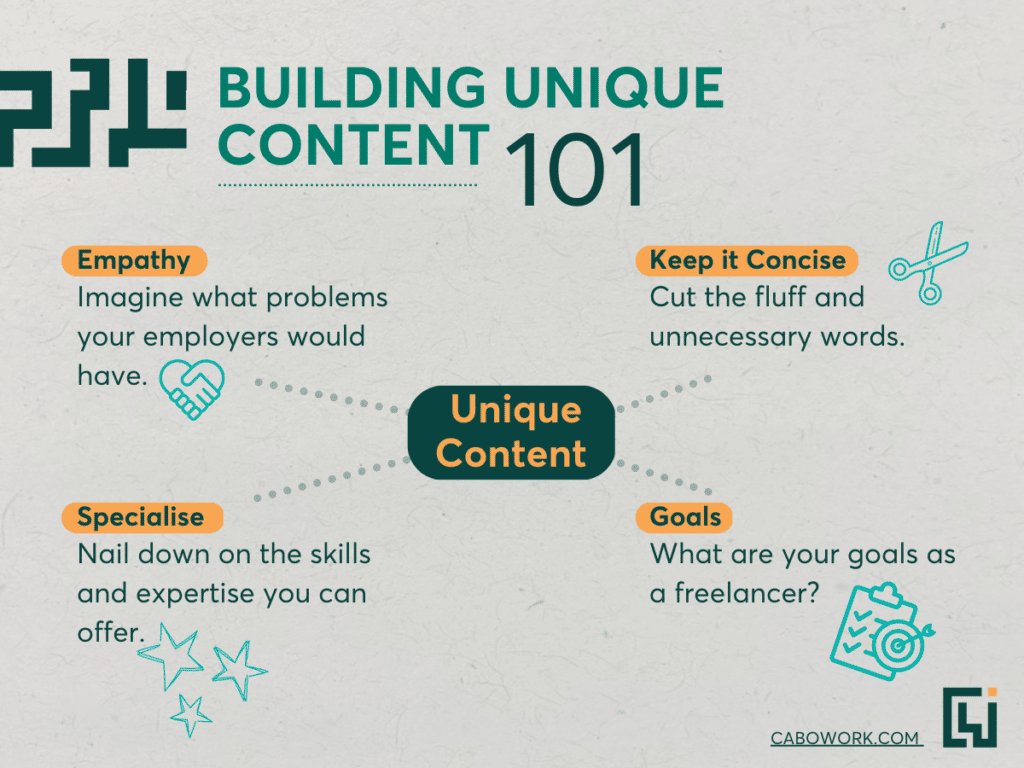
Put yourself in your client’s shoes.
What is empathy?
It’s the ability to understand and share the feelings of another. It’s also one of the most powerful tools you have at your disposal when creating your freelance profile.
Infuse your profile with empathy to show your potential client that you understand what they are looking for and, better yet, you offer the perfect solution.
How can empathy and target audience research help you?
Whether you are writing a persuasive blog post or crafting a unique freelance profile, you are writing to an audience. Without clearly understanding what that audience is looking for, you’ll quickly be replaced by someone who does.
To discover what your audience wants, you’ll need to do some research. We recommend looking at other freelancers who provide a similar service to yours and noting what makes their profile successful.
For example, if you are a freelancer specialising in web design, you may find that other successful freelancers write about helping their clients “stand out” by creating “unique content”. From this, it’s clear that these clients have a need to separate themselves from the crowd and offer a truly special service.
Now, on the freelance site where you have your profile, you can showcase your expertise by describing ways you yourself have helped clients stand out and get results. You can even offer some initial suggestions to prove your expertise further.
Questions to consider:
- What are the pain points of my target client?
- What one thing does my target client need?
- How can I improve upon what other freelancers are offering?
Avoid rambling and unnecessary fluff.
Ask yourself whether the information you are including is directly relevant to the service you provide. You may be tempted to write about the unique volunteering experience you had seven years ago, but if it doesn’t serve a purpose for engaging your clients, it’s best to leave it out.
Why should you try to be concise?
On average, searchers read 20% of a webpage before clicking away. To keep potential clients on your page you need to make your words count.
Regardless if you are a digital marketing expert or full-stack developer, your profile should be tailored towards your chosen field. Attempting to generalise here will at best water down your achievements, and at worst leave your potential client confused about your offering.
3 ways to reduce wordiness in your profile:
We can take inspiration from other forms of writing in looking for ways to reduce wordiness. Here are three methods you can use:
- Look for common phrases that can be made more concise. For example, ‘would be able to‘ can become ‘could‘ and ‘in order to‘ can become ‘to‘.
- Remove unnecessary modifiers, such as ‘really’ or ‘very’. ‘Really creative‘ can become ‘creative‘.
- Consider using bullet point lists to showcase information. Bullet points can help you to naturally keep your message to the point.
Specialise or generalise?
Becoming a master in your field comes from dedication to your craft and a thorough understanding of it. Specialising doesn’t mean that you need to rush off and take a two-year intensive course in an obscure niche, but rather that you focus on and mention in your profile the areas that you like to work in, or better yet, have experience in.
Generalising isn’t a bad idea either. In fact, it can be quite useful for getting a broad understanding of your chosen topic. To stand above the rest in your chosen field, you’ll need to decide whether you wish to specialise or generalise more.
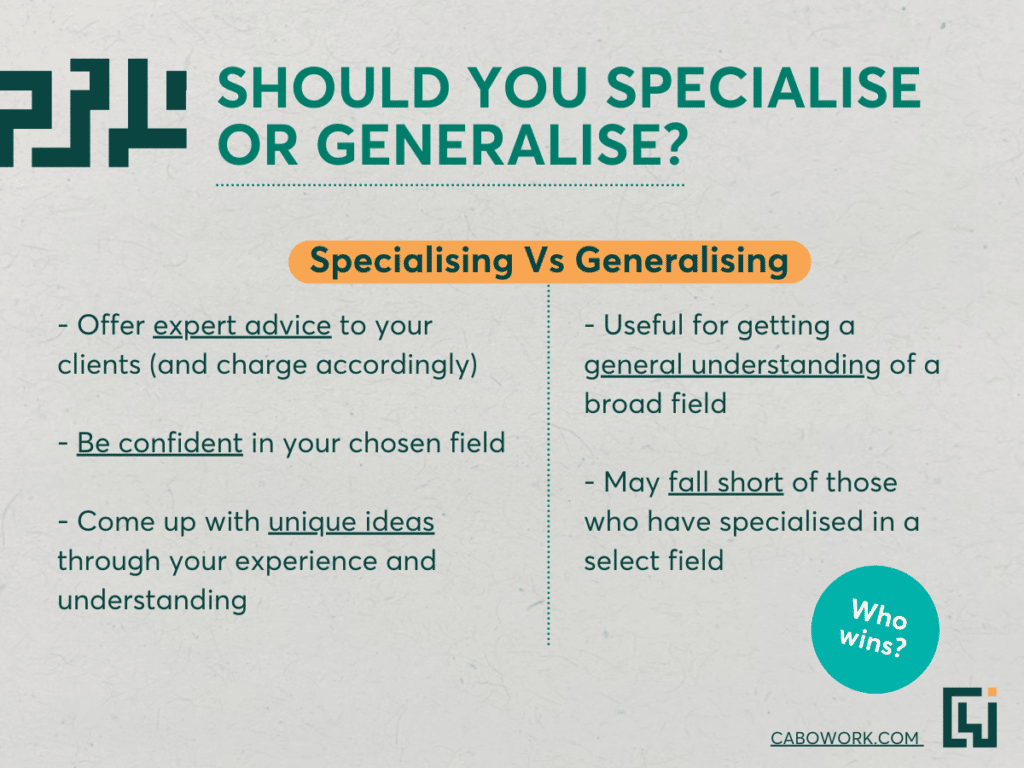
Why is it a good idea to specialise?
Specialising can help you stand out above the crowd. For example, simply stating that you are a “blog writer”, doesn’t tell us much. There may be 1000 blog writers vying for the top spot, so what would help one to stand out?
Let’s say our blog writer specialises in the pet niche – simply writing “Specialising in the Pet niche” in a prominent place (such as the headline or beginning of the content) will make it much easier for future clients in the same niche to find them.
This isn’t to say you have to specialise in just one area – you can also look for complementary niches or areas of expertise, such as improving website performance or writing for S
Two examples of profile specialisation:
Let’s look at two more examples showing how specialising can help:
Example 1:
Original: “Graphic Designer With 5 Years Of Experience”
Specialised: “Experienced Graphic Designer Specialising In Logo Design And Infographics”
Example 2:
Original: “Developer With Python And JavaScript Certifications”
Specialised: “Certified Software Developer | Python & JavaScript”
Showcase your portfolio (or create one!).
Harnessed correctly, your portfolio can be a powerful tool that propels your profile to the top of the search list. Potential clients look for relevant experience, and your portfolio can showcase that to them.
How can my portfolio help me land clients?
Aside from providing hard proof of your expertise, your portfolio can also differentiate you from other freelancers who don’t have one. You can display your certifications, education, and other relevant information within your portfolio.
You can also use your portfolio as a chance to get clients onto your own professional website (if you have one). A simple link in your profile to your website, where your portfolio is easily found, will help to promote a professional image. This can work for all business types, whether you are a graphic designer or a freelance writer.
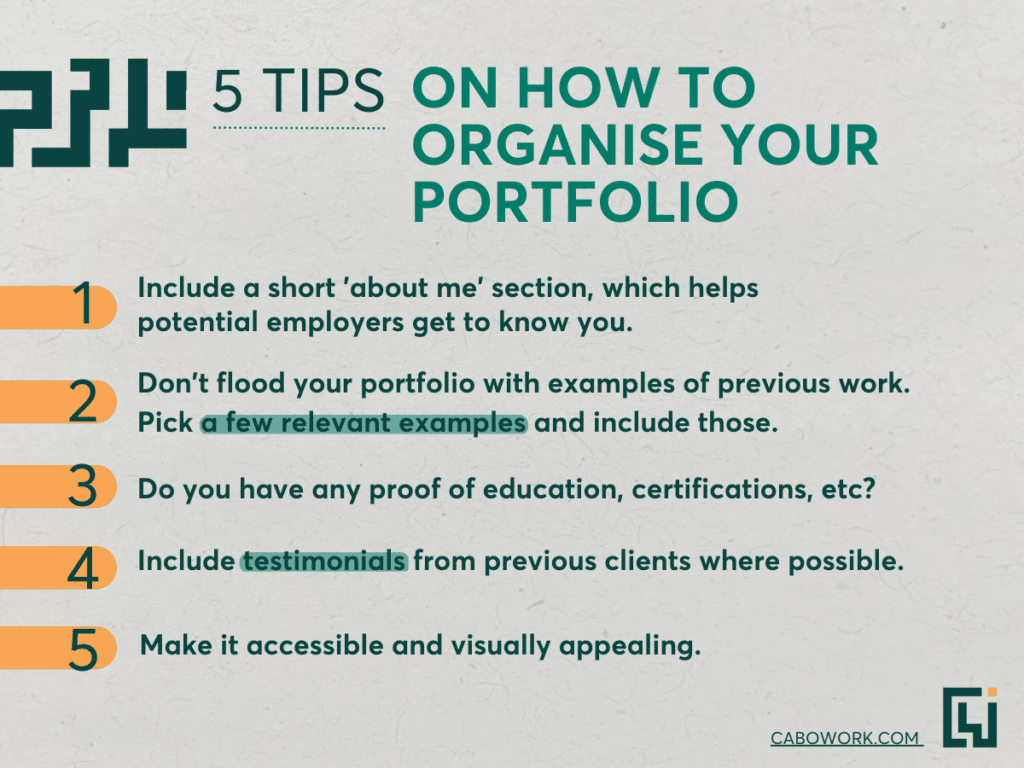
Display relevant (and interesting) experience.
Alongside your portfolio, relevant experience is a strong indicator of your skills and the field you specialise in. When used with positive testimonials, it can be very persuasive for potential clients.
Why is experience such an important indicator of expertise?
Without previous experience, a profile can feel shallow to employers. That’s not to say that you can’t succeed without it (everyone has to start somewhere!), however if you do have experience, we strongly recommend you make the most of it.
Previous experience can also demonstrate that you have the drive to complete projects to a high standard. Stats and figures can really help you to stand out amongst the crowd.
How to select the right previous experience for your profile
Rather than including every single piece of job experience on your profile, it can be much more effective to choose the experience that closely relates to your specialised field.
If you have recently switched to a new field or niche, select previous experience that showcases core skills or achievements. If you’re unsure which skills relate to your chosen field, we recommend that you do a little bit of research online to find the most relevant skills.
Even if you have only completed a few jobs previously, it can be well worth considering which skills that experience helped you to develop.
Step 3: Final touches
Once you’ve written the bulk of your profile, it’s time to add the final touches that will help it to really shine. You’re near the end now, so take a moment to pat yourself on the back!
Always, always review your profile
The most impressive profile can be ruined instantly by typos, grammatical errors and incorrect formatting. Once you have finished crafting your freelance profile, you’ll want to thoroughly check it for these issues.
Why is it important to double-check your profile?
Your profile is an extension of your professional persona – a profile that is full of mistakes does not project a positive image and can quickly turn potential clients away. Let’s take a look at a few ways that you can ensure your profile is error-free.
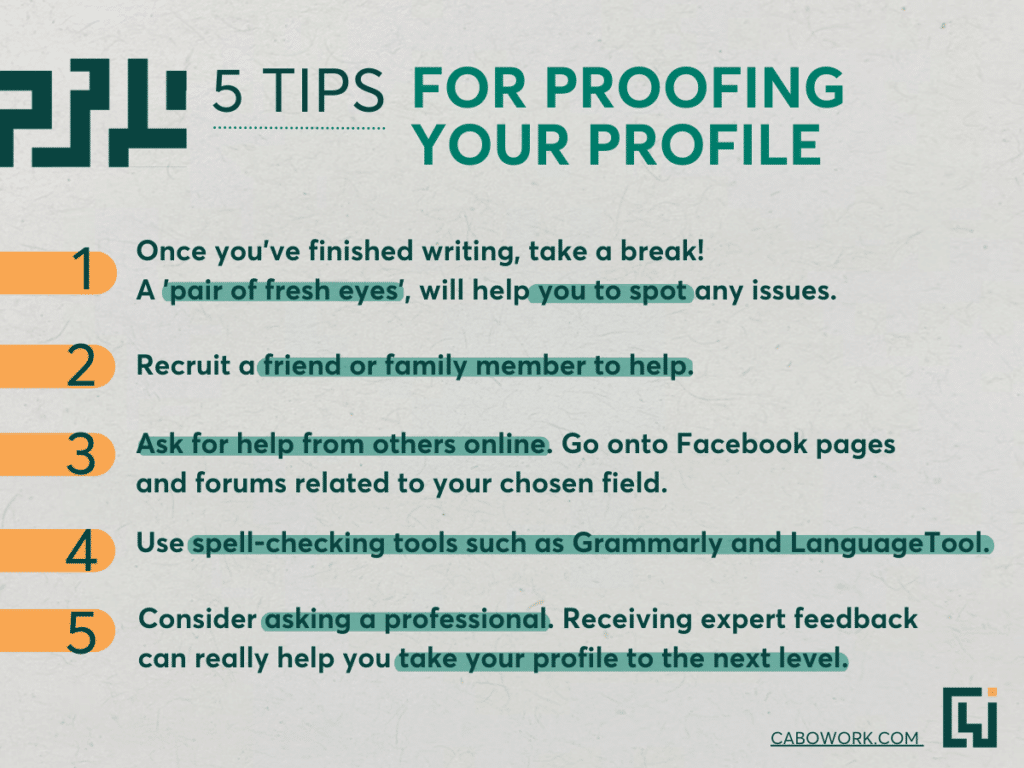
Include links to relevant social media accounts
Where possible, we also recommend linking to any professional social media channels that you have created. You don’t have to plaster your profile with links, but can instead include these towards the bottom of your profile.
How will social media help me land more clients?
Including links to social media can also help to drive more clients, even if you don’t work in social media marketing! Websites such as LinkedIn can showcase your online presence and provide another platform through which clients can reach out to you. You’ll be able to grow your network with each successful project, promoting a steady flow of work.
